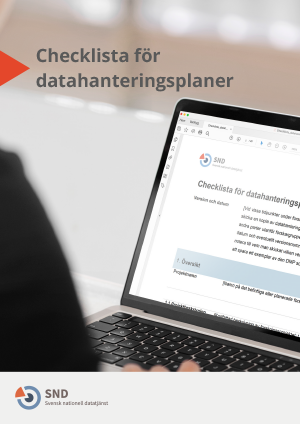Checklist for data management plans
 To assist researchers in writing a data management plan, SND has developed a comprehensive DMP checklist. It can serve as support in identifying which parts of data management are relevant to your specific project, and it is adapted to current conditions and regulations for researchers in Sweden.
To assist researchers in writing a data management plan, SND has developed a comprehensive DMP checklist. It can serve as support in identifying which parts of data management are relevant to your specific project, and it is adapted to current conditions and regulations for researchers in Sweden.
SND’s DMP checklist is designed to be used throughout a research project and for different disciplines, data types, requirements from research funding organizations, as well as various legal requirements. It is regularly updated to comply with recommendations from, for instance Horizon Europe, the previous European programme Horizon 2020, and Science Europe, which are also the foundation for the DMP Template from the Swedish Research Council and the Association of Swedish Higher Education Institutions, SUHF.
You can download a ZIP file with the checklist in an editable text format , containing the Swedish and English versions of the checklist in .docx och .rtf formats.
If you want to view or download the checklist in a PDF format you can do so on Zenodo:
Start by reading the checklist to get an overview of what it contains. Identify which parts of it that are relevant to your research project. Then start writing your project’s data management plan by entering the information you already have. Remember that a data management plan is a living document that should be updated as the research project progresses.
Contact your local support function for research data if you need assistance with your data management plan.
You can read more about data management plans on Researchdata.se: Data management plan.
SND’s checklist is divided into seven main sections
1. Overview. Who is the primary investigator and are there more contributors to the dataset? Which higher education institution or organization is the research principal? Who in the project team is responsible for what? Are there specific guidelines for the DMP that you need to follow, for example from your university or a funding organization?
2. Protect the research data. Does the research need ethical approval? Do you need to follow a policy on information security and how are your data classified in terms of confidential information, personal data, or research collaboration agreements? If you will be processing personal data, document how you will comply with GDPR and ethical requirements. Will you work with copyright protected data; if so, how are you going to manage them?
3. Collect/produce research data. Describe which type(s) of data you will be using in the project, both reused existing data and data you will produce or collect.
4. Document the research data. What type of documentation and metadata will you produce?
5. Organize the research data. Describe the strategy for file names and folder structure you plan to use in the project, and what rules you have set for file versioning, data storage, and routines for making backups of the files. If possible, describe which file formats you will use.
6. Costs for managing the research data. What budget do you estimate you will need for personnel, storage, technical hardware and software throughout the project?
7. Preserve and publish the research data. Which data will you be publishing with open or restricted access? Which data repositories are best suited for your type of research data, and what are their requirements on documentation and metadata? Who is the research principal, who is responsible for archiving the research material, and how do you plan for long-term preservation?
For additional help with the information in the various sections of the data management plan, see for example the introduction to legal aspects of research under Research Data Support, and Manage data at Researchdata.se.
